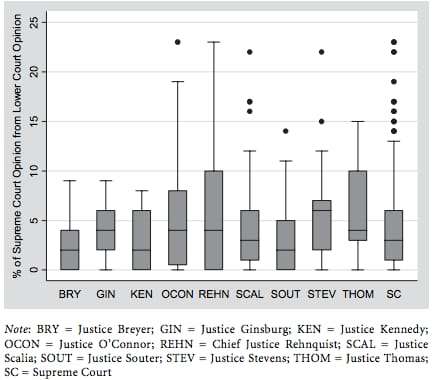The Volokh Conspiracy
Mostly law professors | Sometimes contrarian | Often libertarian | Always independent
A misleading story about Justice Thomas
The home page of the New York Times has this provocative link:

The story begins by presenting Justice Thomas as a real outlier:
Justice Clarence Thomas has not asked a question from the Supreme Court bench since 2006. His majority opinions tend to be brisk, efficient and dutiful.
Now, studies using linguistic software have discovered another Thomas trait: Those opinions contain language from briefs submitted to the court at unusually high rates.
It continues:
Justice Thomas's seven majority opinions in the last term were on average just 12 pages long and contained little but a summary of the facts and terse summaries of the relevant statutes and precedents. Since opinions are signed by justices but often drafted by law clerks, it may be that any borrowed language was the work of Justice Thomas's clerks.
When Justice Thomas announces his majority opinions from the bench, he sometimes seems to be reading from materials prepared by others. In June, he slipped in a playful aside. What he had just read, a description of synthetic drugs, he said to laughter, was "a sentence which I completely do not understand."
Sounds significant, right? The implication is that Justice Thomas is not doing his job. Not only does he not ask questions, he doesn't even think for himself.
For the New York Times audience, it's the kind of ideological catnip that is likely to make a lasting impression. No wonder it has been a main link on the Times homepage for most of the last day.
If you look at the data, though, they don't support the conclusion that Justice Thomas is an outlier. Let's look at the studies Liptak relies on in his article.
First up is the Feldman study, which gets the most attention in Liptak's paper. Feldman compared how much of majority opinions by different Justices contained language from the merits briefs. Feldman did not include the Justice-by-Justice numbers in his paper, but he calculated them for Liptak and he kindly shared the results with me by e-mail. Here are the percentages in descending order:
Thomas: 11.29%
Sotomayor: 11.04%
Ginsburg: 10.55%
Alito: 9.48%
Roberts: 9.20%
Scalia: 8.74%
Kennedy: 8.36%
Breyer: 7.56%
Kagan: 7.13%
The numbers seem at odds with Liptak's claim. Yes, Thomas has the highest shared language percentage. But it's bizarre to say that his numbers are "unusually high," that Thomas "relies heavily" on outside language or that "many" of his words are "not his own." All of the Justices share language from the briefs at roughly similar rates: about 7 to 11 words out of 100. And the difference between Thomas and Sotomayor is a rounding error. It's only 2.5 words out of 1,000. In a typical majority opinion, that's probably the difference between including a short parenthetical quote from a precedent and leaving it out.
Liptak relies on two additional studies. These two studies looked at three Terms from over a decade ago: 2002, 2003, and 2004. Only five of the current Justices were on the Court then, so we have no idea how the Chief, Alito, Sotomayor or Kagan might measure up. They show Justice Thomas sharing language with lower court opinions and amicus briefs slightly more than other Justices. But the differences strike me as pretty modest.
The first study looked at overlaps between majority opinions and lower-court opinions. Liptak wites: "Here again, Justice Thomas's rate was the highest, at 6.2 percent. Justice Stephen G. Breyer's was the lowest, at 2.6 percent." Here's the key chart from the paper:

It turns out that in the small data set of three terms, about 20 opinions each, Justice Thomas averaged a bit higher overlap with lower court opinions than other Justices. With that said, all of the Justices are pretty well bunched up together. Eyeballing the averages, and the ranges, what stands out to me is that none of the Justices seem to really stand out.
The other study looked at overlap between majority opinions and amicus briefs, also from 2002-05. Liptak reports that "Justice Thomas's majority opinions incorporated language from friend-of-the-court briefs at 4.4. percent, more than than any other justice." Here's the key chart from that paper:

Justice Thomas does seem to have shared language from amicus briefs slightly more than other Justices in 2002-04. But the differences are modest. Justice Thomas shared 4.4% of the language, and Justice Ginsburg shared 3.5%. That's a difference, but it's not a big one. And as with the earlier study, we don't know how the four Justices who joined the court since 2005 might measure up. The study authors also note that the opinions that shared the most language with amicus briefs were not authored by any one justice:
Looking at the outlier values, it is clear that the opinions that integrated the most language from amicus briefs are fairly evenly dispersed among the justices, with the highest percentage corresponding to Rehnquist's opinion in Connecticut Department of Public Safety v. Doe (2003) (35%), followed by Souter in Breuer v. Jim's Concrete (2003) (31%) and Ginsburg in Intel Corporation v. Advanced Micro Devices (2004) (25%).
I don't see how these studies support the Times's presentation of Justice Thomas as an outlier.
Even if these small differences are indicators of something, I'm not sure what that thing is. Are marginally higher numbers numbers supposed to show that Justice Thomas is taking his ideas from elsewhere more than the other Justices? Or are they supposed to show that Justice Thomas likes to include more or longer quotations from precedents and from the lower court opinion, perhaps giving the reader slightly more doctrinal context than do other Justices? As far as I can tell, the studies that look for word overlap don't distinguish between these very different possibilities.
To get the Volokh Conspiracy Daily e-mail, please sign up here.


Show Comments (0)